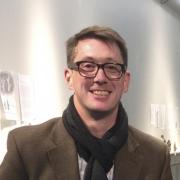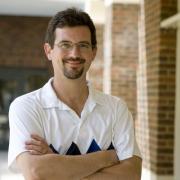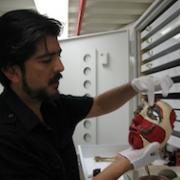The Mellon Indigenous Arts Initiative is pleased to announce three Mellon Arts Fellows for 2017-18. Each faculty fellow will research and develop a new course curriculum related to Indigenous arts.
 Douglas Fordham, Associate Professor of Art History, McIntire Department of Art
Douglas Fordham, Associate Professor of Art History, McIntire Department of Art
Project Description: A striking development in contemporary aboriginal art has been its use as evidence in native title claims, most notably in the Ngurrara Canvas. My project proposes a deeper history for the intersection of legal rights and artistic production. It is a project inspired by Ian McLean’s recent characterization of Indigenous art since colonization as a continuous and evolving engagement with Western modernity. Settler colonialism brought with it a particularly entangled knot of legal claims around territory, representation, and personhood. My hypothesis is that the legal status of the image (as visual evidence, copyrighted product, etc…) can help to connect and complicate current narratives of “Australian modern art”, evoking transcultural practices dating back to 1788. In particular, I will focus on the period between the Flinders expedition of 1801-5, of which William Westall was the official draughtsman, to the R. v. Ballard case of 1832 in which the court of New South Wales wrestled with the applicability of crown law to indigenous plaintiffs and defendants.
 Matthew Burtner, Professor and Chair, McIntire Department of Music
Matthew Burtner, Professor and Chair, McIntire Department of Music
Project Description: Building on my research with ecoacoustics of climate change and human-nature interaction in music, I will study Yidaki music in Australia and in collaboration with the Kluge-Ruhe Aboriginal Art Collection. The Yidaki instruments are fashioned from termite-hollowed eucalyptus trees, selected and shaped by Aboriginal musicians. I am interested in how the Yidaki instruments reveal a philosophy of sustainability and creativity that may influence contemporary music practice and instrument design. My current music involves the sounding of natural materials played in counterpoint with sonifications of climate change, and realized with computer technology and acoustic instruments. The Yidaki offer a fascinating example of a hybrid human and nature-fashioned instrument and performance practice closely tied to environmental sustainability. Because ecoacoustics promotes sustainability through music, students can benefit from the knowledge of the Yiirkala people who developed these instruments. As a Mellon Indigenous Arts Fellow, I will create a new Ecoacoustics class that brings together a study of Yidaki and environmental science to explore climate change music.
 S. Max Edelson, Associate Professor of History, Corcoran Department of History
S. Max Edelson, Associate Professor of History, Corcoran Department of History
Project Description: My research focuses on indigenous cartographies and works of art that express geographic knowledge and a sense of place. It begins from a simple but expansive question: How did Native peoples understand and represent space across time and world regions? It seeks to highlight representations of geography at the intersection of two mapping traditions: one advanced by European empires and their settler-society successors that use empirical, western cartography as a tool of colonization, administration, and development; and the other advanced by those displaced, threatened, incorporated, and subjugated by these imperial societies, from ca. 1500 to the present. As a Mellon Arts Fellow, I will work to identify a global corpus of works that articulate indigenous geographic knowledge in compelling ways. Through visualizing this collection with new digital tools (such as MapScholar and Neatline—both geospatial platforms developed at UVa), I will work with students to describe these objects and show the commonalities as well as the variation within “indigenous cartographies.” This new collaborative course, a digital “practicum” in map and art history, will bring students together around the common project of building an interactive online exhibition of indigenous maps and spatial art featuring objects from the Kluge-Ruhe Aboriginal Art Collection.
 Alessandro Questa, Ph.D. Candidate, Department of Anthropology
Alessandro Questa, Ph.D. Candidate, Department of Anthropology
Project Description: During my time as a fellow at the Mellon Indigenous Arts Program at UVA, I plan to: a) continue my ethnographic research among Masewal indigenous farmers in central Mexico, specifically regarding the unforeseen reappearance of several documents (two codices and two maps) from the 17th century and the current local debates and contrasting interpretations of these, in light of diverse political agendas and local cultural revitalization projects, b) produce a manuscript for a journal paper on the matter, and c) develop a course for the University incorporating, under an interdisciplinary scope, cultural anthropology, history, and Mesoamerican iconography.
This research is a continuation of my interest in the intersection between creativity, crafts and embodied practice with cultural values, cosmologies, and modernity. In 2013 I was invited by some Masewal people to see a series of documents preserved at the local church in Tepezintla. Two long strips of paper —taken from an early 17th century Bible—were repurposed to depict two lines of human figures. At the center was, still preserved in colors, a brown-green mountain and a blue river. The other documents, a couple of maps, showed an aerial view of the village’s church as an omphalos, surrounded by mountains, each with its name inscribed, using the Latin alphabet but Nahuatl language. The documents in question are an extraordinary sample of historic indigenous visual art, documentation and conceptualization of their territory. My research now is devoted to understanding what these documents mean for Masewal people today.
